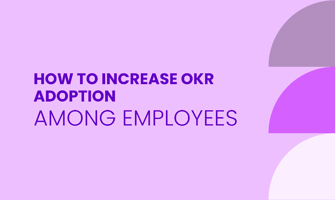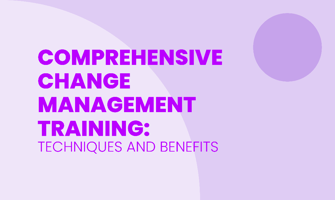OKR adoption involves integrating Objectives and Key Results into the daily routines and practices...
What is Change Management? An Introductory Guide
Change management is the systematic approach to transitioning or transforming an organization's goals, processes, or technologies. It involves planning, implementing, and monitoring changes to ensure they are effective and sustainable. The goal is to help organizations adapt to new conditions smoothly, minimizing disruptions and resistance.
Effective change management enables organizations to implement changes efficiently, ensuring minimal resistance and promoting widespread adoption among employees. It is essential for staying competitive and achieving long-term success.
This article covers the key aspects of change management, including its steps, best practices, and essential tools. It provides a comprehensive understanding of how change management can be applied successfully in your organization.
Identifying When Change Management is Needed
Recognizing when to implement change management is essential for organizational success. Tools like 180ops, which is highly rated on G2, can help detect the need for change management. Key indicators include:
Drop in Performance Metrics: Indicates outdated or inefficient processes.
Introduction of New Technology: Requires organization-wide adoption.
Mergers and Acquisitions: Involves blending corporate cultures and systems.
Legal and Regulatory Changes: Necessities updates in compliance procedures.
Cultural Transformation: Aims to rejuvenate company culture.
Change management refines internal processes and makes necessary cultural adjustments to navigate these shifts effectively. It lays the groundwork for new initiatives with due diligence and foresight.
![]()
Steps and Best Practices for Effective Change Management
Change management involves a structured approach to transitioning individuals, teams, and organizations from a current state to a desired future state. Here are the key steps for effective change management:
Initial Assessment: Understand the current state of your organization, including its culture, internal processes, and technological infrastructure. This helps identify areas needing change and sets a baseline for measuring progress.
Defining Objectives: Clearly articulate the change goals — what you aim to achieve and why it's necessary. Specific and measurable objectives help guide the change process.
Strategic Planning: Develop a strategic plan detailing the path from the current state to the desired state. This plan should outline the resources required, potential obstacles, and key milestones.
Communication: Communicate the change clearly and frequently to all stakeholders. Effective communication ensures understanding and buy-in, reducing resistance.
Training and Support: Provide comprehensive training and support to employees. This helps them understand the change and equips them with the necessary skills to adapt.
Monitoring and Adjustment: Monitor the progress and impact of the change. Regular reviews allow for adjustments to address any issues and stay on course.
Review and Reinforcement: Once the change has been implemented, review its success and reinforce new practices to prevent reverting to old habits.
Here are the best practices for effective change management
Involvement at All Levels: Involve employees at all levels in the planning stages. This fosters ownership and eases the implementation process.
Transparent Communication: Maintain transparent communication throughout the process. Transparency builds trust and keeps everyone informed and engaged.
Foster a Culture of Change: Encourage a culture that embraces change. Supportive leadership and a positive attitude toward change can significantly ease transitions.
Utilize Change Management Tools: Strategic use of tools can aid in the smooth implementation of new systems or procedures. Tools can help in tracking progress, managing resources, and ensuring effective communication.
To learn more about steps and best Practices for Change Management, explore our detailed guide Understanding the Change Management Process: Steps and Best Practices
![]()
Key Models of Change Management: Kotter, Lewin, and More
Several change management models provide structured approaches to guide you through organizational transformation. Understanding and applying these models can significantly enhance the chances of successful change implementation. Key models include:
Kotter's 8-Step Process: Developed by John Kotter, this model involves eight steps to implement change: creating urgency, forming a powerful coalition, creating a vision for change, communicating the vision, removing obstacles, creating short-term wins, building on the change, and anchoring the changes in corporate culture. The importance of this model is that it emphasizes the need for a strong leadership coalition and a clear vision to drive change.
Lewin's Change Management Model: This model consists of three stages: unfreezing the current state, moving to the new state, and refreezing the new state as the standard practice. The importance of this model is that it provides a clear, step-by-step framework for implementing change and ensuring it becomes part of the organizational culture.
ADKAR Model: The ADKAR model stands for Awareness, Desire, Knowledge, Ability, and Reinforcement. It focuses on managing change at the individual level. The importance of this model is that it ensures employees are equipped and motivated to support and sustain the change.
McKinsey 7-S Model: This model involves seven interdependent factors: strategy, structure, systems, shared values, style, staff, and skills. The importance of this model is that it emphasizes that all parts of the organization must be aligned and mutually reinforcing for effective change.
Developing a Successful Change Management Plan
Creating a successful change management plan involves a structured approach addressing all facets of change. Here's an overview of the key steps:
Assess the Impact: Evaluate how the proposed change will affect your organization, including its culture, processes, and employees.
Establish Clear Objectives: Set clear, achievable goals for the change initiative.
Develop a Communication Strategy: Outline how information will be disseminated to employees and stakeholders.
Design Training Programs: Identify training needs and develop programs to address skill gaps.
Designate a Change Team: Assemble a team to oversee the change process and manage tasks.
Plan for Resistance: Anticipate resistance and develop strategies to manage it.
Set a Timeline: Create a realistic timeline for the change process.
Techniques and Benefits of Comprehensive Change Management Training
Change management training equips team members with the skills and knowledge necessary to adapt to new processes or systems effectively. The right training techniques can make the difference between a smooth transition and a turbulent one. Techniques to consider include:
Interactive Workshops: Facilitated sessions that encourage active participation and practical skills application.
E-learning Modules: Online courses that can be accessed remotely, providing flexibility for staff with varied schedules.
Simulation Exercises: Role-play scenarios that mimic future states, helping employees practice new procedures in a controlled environment.
Support Groups: Peer groups that offer a forum for employees to share experiences and strategies for handling change.
Comprehensive training not only prepares employees for new roles or technologies but also fosters a culture of continuous learning and adaptability. Benefits include increased morale, reduced fear of change, and accelerated adoption of new practices. These improvements can translate to better organizational performance and a competitive edge.
For an in-depth understanding of Techniques and Benefits of Change Management Training, check out Comprehensive Change Management Training: Techniques and Benefits
![]()
Essential Tools for Managing Change
Managing change effectively requires using the right tools to guide and support the process. Key tools for change management include:
Project Management Software: Helps track tasks, timelines, and responsibilities related to the change.
Employee Feedback Platforms: Collects real-time insights and sentiments from employees.
Change Readiness Assessments: Evaluate how prepared your organization is for change.
Impact Analysis Tools: Analyze the effects of change on different parts of the business.
Communication Platforms: Ensures effective information sharing across teams and departments.
These tools make the change process more efficient and improve communication. By using the right tools, you can keep everyone aligned, engaged, and ready to support the change.
Creating a Strong Change Management Strategy
A strong change management strategy is essential for ensuring that the desired transformation is achieved with minimal disruption. This strategy acts as a guide for decision-making and actions throughout the change process. Here’s how to create one:
Define Clear Goals: Establish what success looks like for the change initiative, with measurable targets.
Identify Stakeholders: Determine who will be affected by the change and what their roles will be.
Assess Risks: Identify potential risks associated with the change and develop strategies to mitigate them.
Establish a Leadership Team: Create a team responsible for driving the change and addressing any issues that arise.
Create a Feedback Mechanism: Develop ways to gather and respond to feedback from employees throughout the change process.
Monitor and Review: Continuously monitor the progress of the change and review the strategy to ensure it remains effective.
Get the complete picture of Creating a Change Management Strategy in our article Developing a Robust Change Management Strategy: Tips and Tricks
Different Types of Change Management Approaches
Change management can take several forms, each with specific characteristics and ideal applications. Understanding these different approaches helps tailor the change management process to suit your organization's needs. Some common types include:
Transformational Change: Constitutes a fundamental change in the organization's culture, strategy, or operating model. This type of change is extensive and can impact the entire organization, requiring a comprehensive and systematic approach.
Transitional Change: Involves significant shifts, like mergers, acquisitions, or the creation of new products or services. Transitional change requires moving from the current state to a new one, often involving multiple steps.
Developmental Change: Involves improvements or enhancements to existing processes or structures. This type of change is usually incremental and aims to optimize performance.
Choosing the right type is important as it impacts the scope, scale, and success of your change initiatives. Transformational change is more complex and requires careful planning and execution, while transitional and developmental changes can be more straightforward and less disruptive.
Essential Skills for Change Management Leaders
Leaders play a key role in guiding the organization through periods of uncertainty and transformation. Here are the essential skills that change management leaders should possess:
Communication Skills: Clearly articulate the vision of change and inspire others to embrace it.
Strategic Thinking: Anticipate the implications of change and plan accordingly.
Empathy: Understand employees' concerns and resistance and address them constructively.
Adaptability: Adjust strategies as challenges arise throughout the change process.
Decision-Making: Make timely and well-considered decisions to keep the change initiative on track.
Conflict Resolution: Address disagreements and resolve them in a way that promotes progress.
Discover the full insights on Skills for Change Management Leaders in our article Key Change Management Skills Every Leader Needs
Why Change Management is Essential for Business Success
Change management is a vital practice that supports every successful business venture. Here are the reasons why change management is essential for business success:
Ensures Strategic Alignment: Helps align new initiatives with your organization's goals and vision.
Minimizes Resistance: Proper management of change reduces employee resistance and increases engagement.
Enhances Agility: Prepares your organization to adapt quickly to market changes and new opportunities.
Improves Efficiency: Streamlines processes and eliminates outdated practices, leading to improved efficiency and cost savings.
Maintains Competitive Edge: Enables your business to stay ahead of the curve by effectively implementing new technologies and strategies.
Without a solid framework for managing change, your organization risks confusion and potential failure to seize new opportunities.
Want to know more about the importance of Change Management for Business Success? Read The Importance of Change Management in Business: Why It Matters for all the details
Conclusion
Change management is essential for modern businesses, helping organizations navigate transformations smoothly. It ensures that changes are implemented effectively, maintaining balance and momentum throughout the process.
To manage change successfully, you need attention to detail, clear communication, and strong leadership. By staying informed about best practices, utilizing essential tools, and developing key leadership skills, you can make the most of change management to your advantage.
FAQs
What challenges do organizations face when preparing to embed changes in company culture and reviewing progress?
Organizations face challenges such as employee resistance, aligning changes with company culture, and ensuring managers lead change management effectively. Proper documentation, change control, organizational structures, and adapting workflows are crucial for a smooth transition.
How can the CIO role support organizational change in software development and IT infrastructure?
The CIO supports organizational change by overseeing IT infrastructure, ensuring alignment with software development goals, agile software development, IT department, and managing change control processes. Proper documentation, strategy formulation, and regulatory compliance are essential aspects.
What are the best ways to prepare for and lead change management within an IT department, focusing on popular models?
Preparing for change management involves identifying popular models, using project management tools, management essentials, professional development, and training managers. Utilizing best practice models, version control software, and maintaining project archives are key components.
How do business strategists use project management to address challenges in organizational change and prepare for it?
Business strategists use project management to streamline workflows, handle change requests, and conduct regular reviews. Strategy formulation, proper documentation, and controlling change are essential to managing organizational change effectively.
What role does project management play in analyzing results and reviewing progress during change management?
Project management helps analyze results and review progress through audit trails, documenting changes, and ensuring regulatory compliance. Regular planning and project post mortems ensure that change management aligns with organizational goals.




